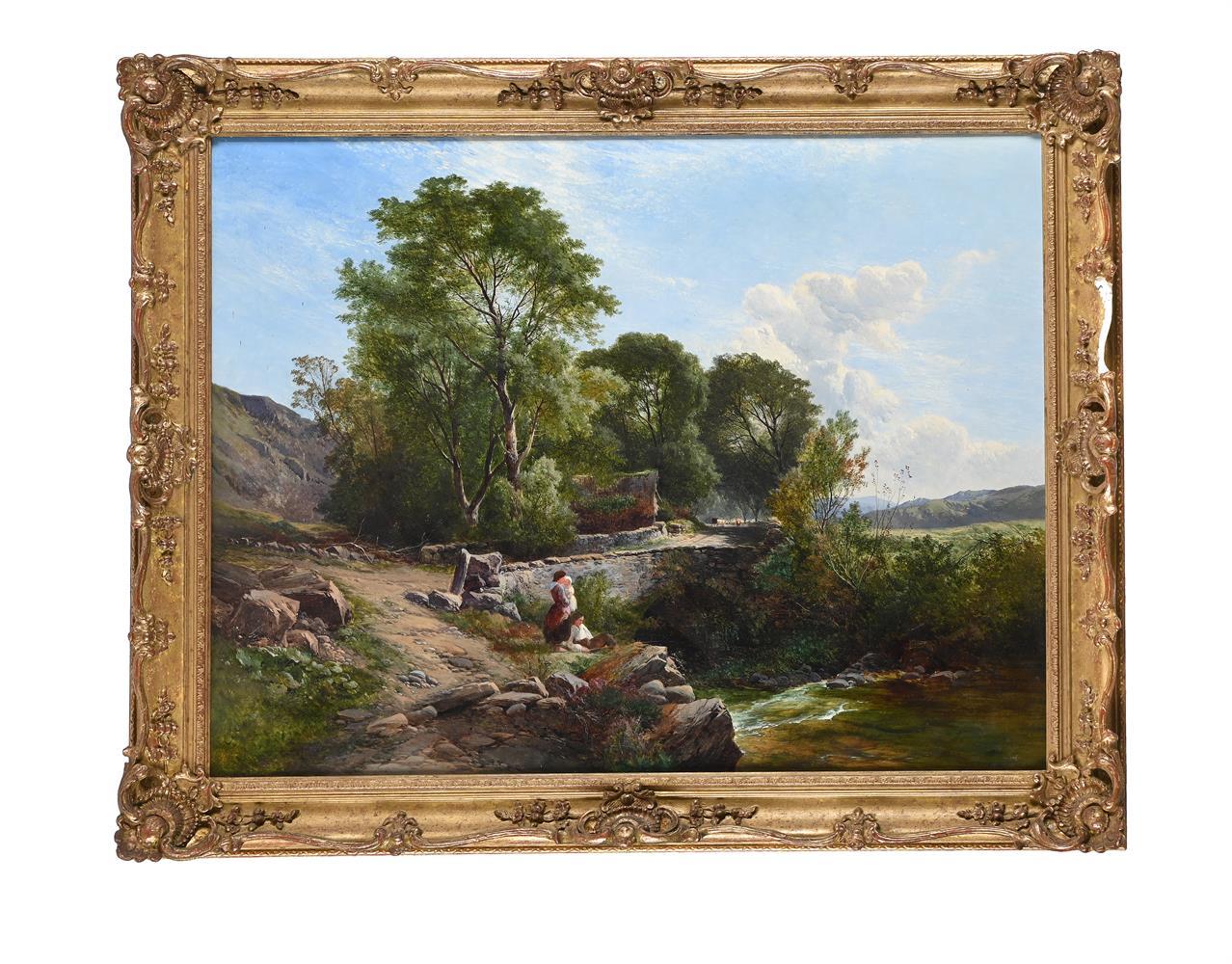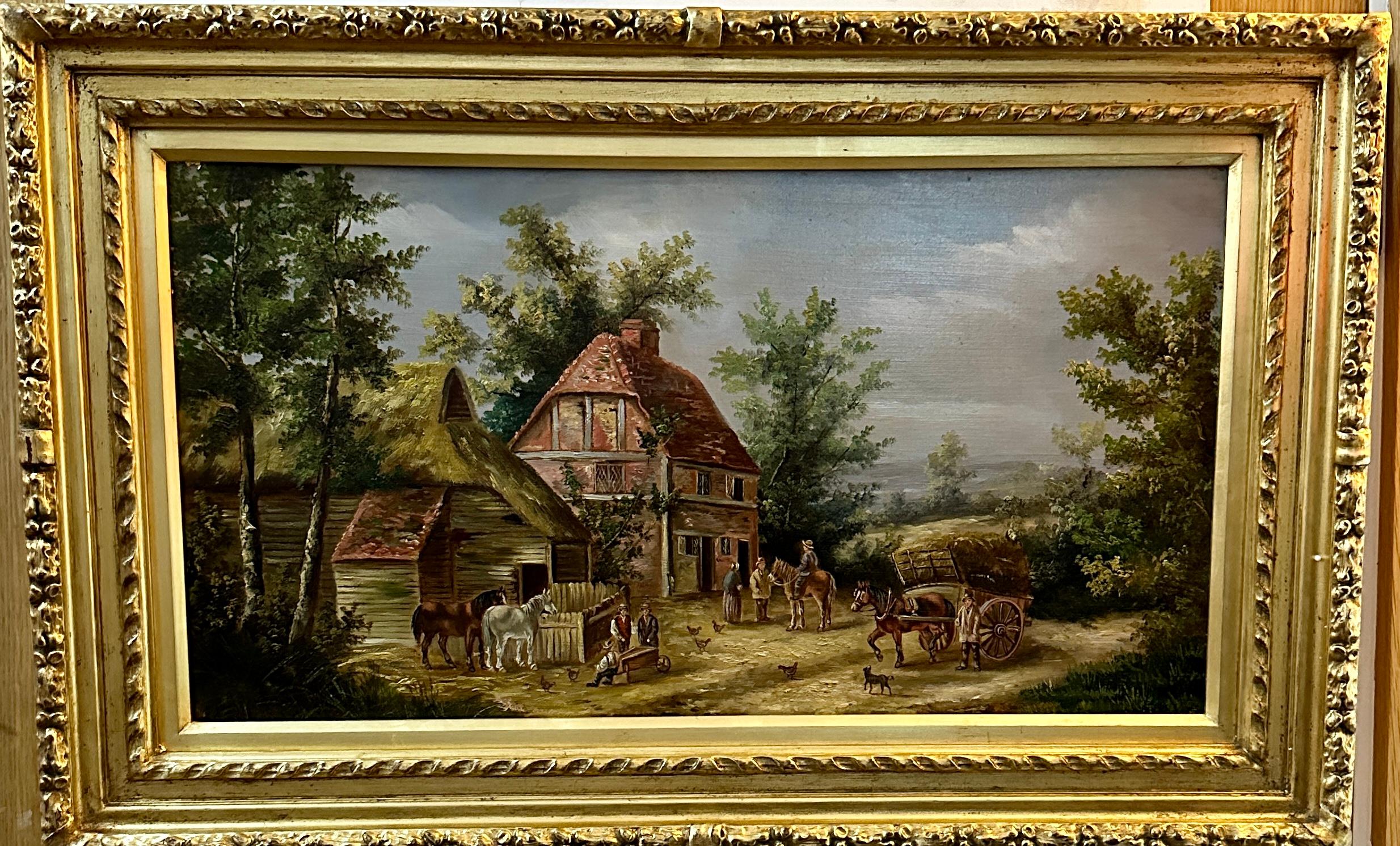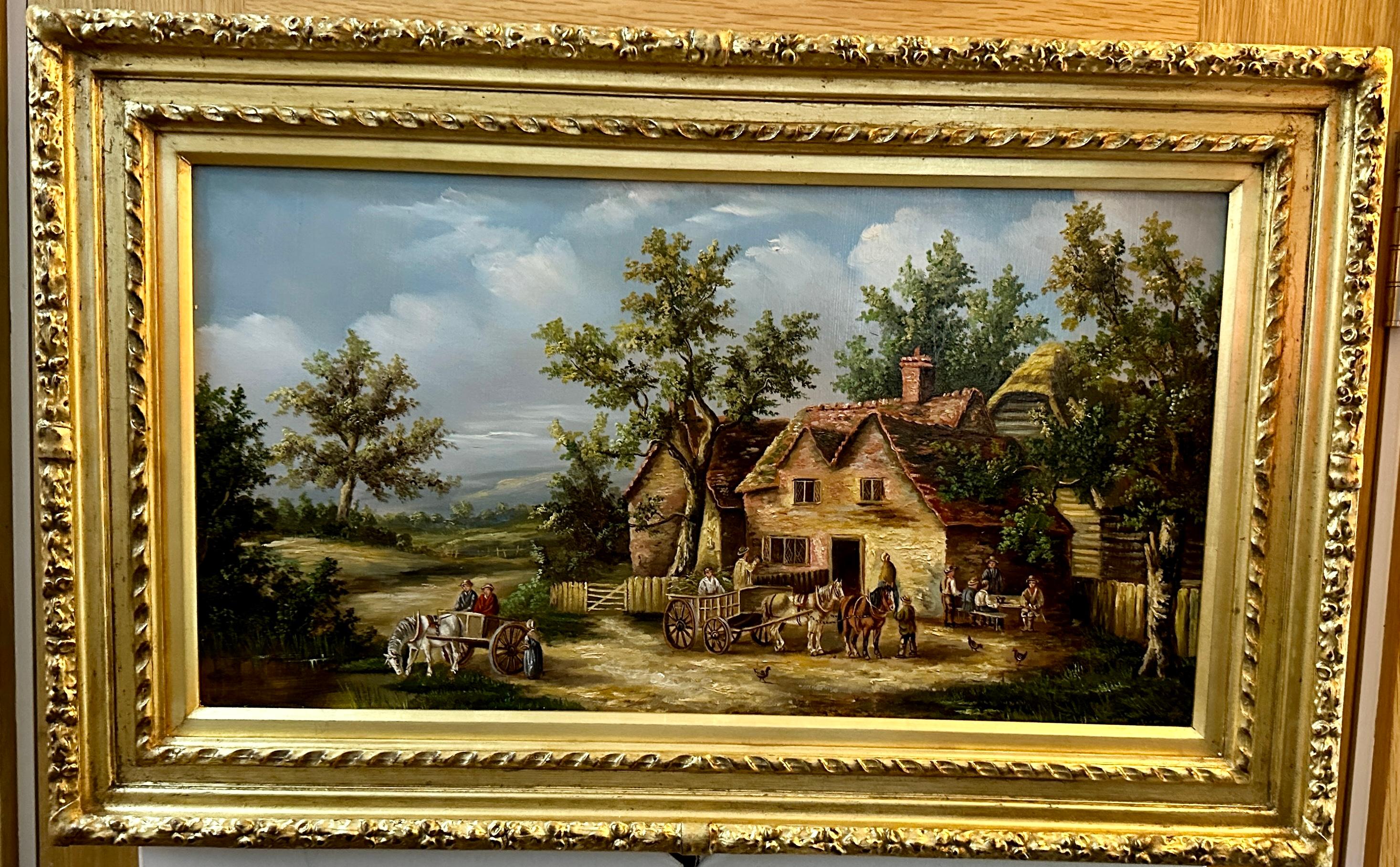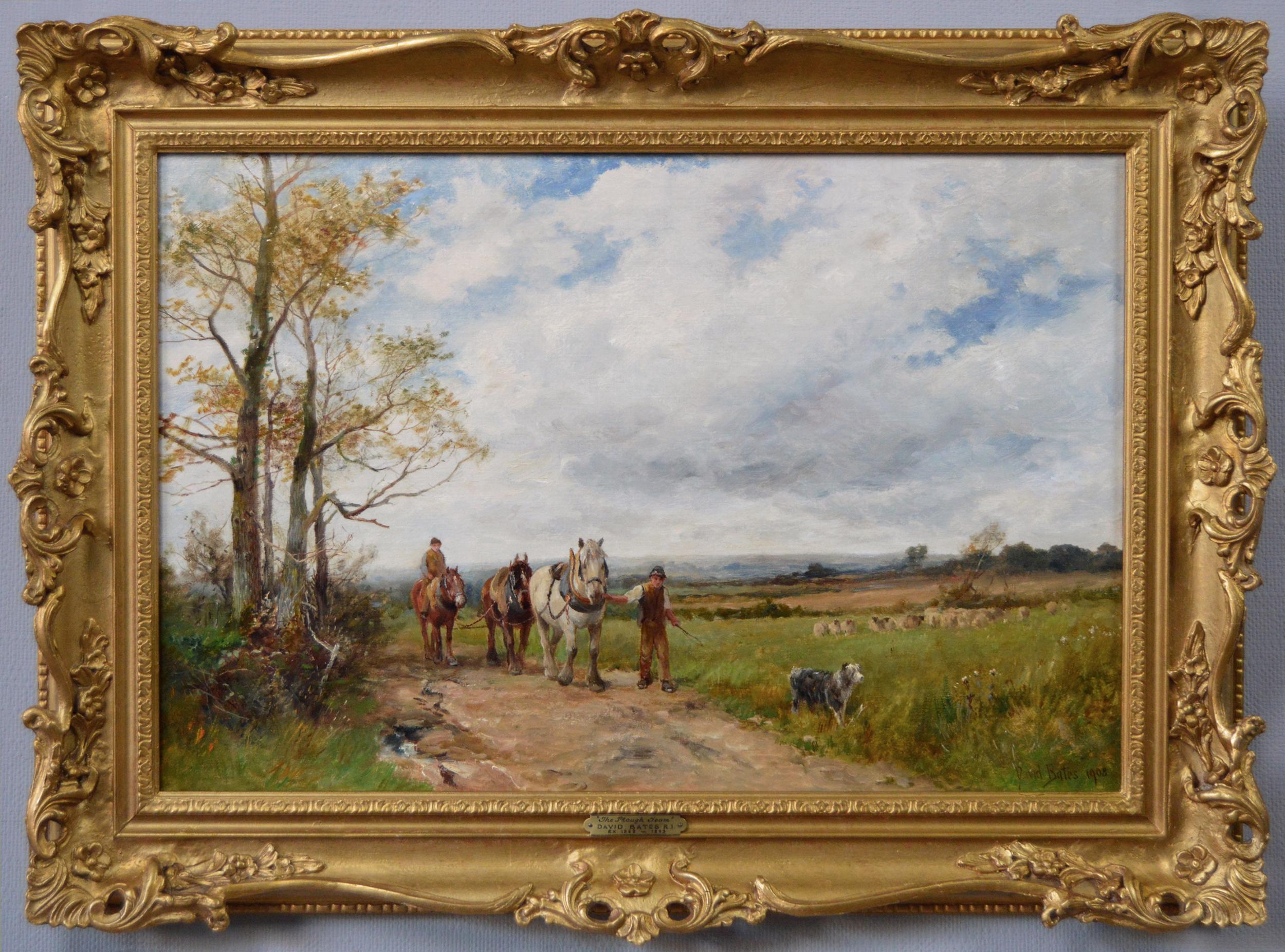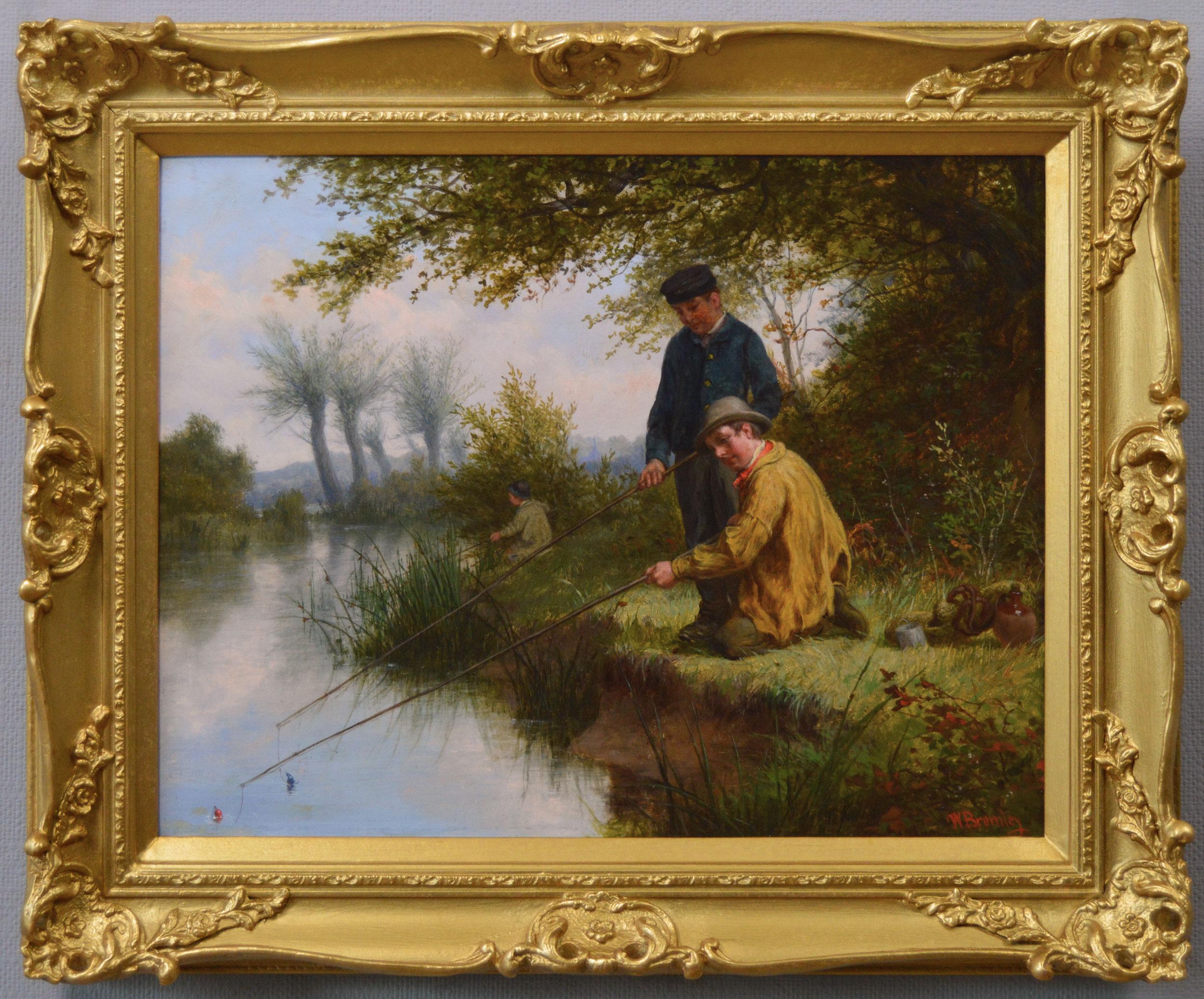Items Similar to Antique Scottish Highland Loch Scene at Sunset Rugged Mountains & Loch Cottage
Want more images or videos?
Request additional images or videos from the seller
1 of 12
Francis E. JamiesonAntique Scottish Highland Loch Scene at Sunset Rugged Mountains & Loch Cottagec.1930's
c.1930's
About the Item
"LochGoilHead"
by F. E. Jamieson (British 1895-1950)
signed, lower corner
oil painting on canvas, framed
framed: 19.5 x 27 inches
Fine quality antique oil painting by the much admired and celebrated British artist F. E. Jamieson (1895-1950). The painting is signed by Jamieson to the lower corner and is a superb example of his work.
The painting captures this majestic Highland loch landscape, with the setting sun warming the rugged mountains as they tower over the old cottage on the shores of the loch - what a place to stay!
The location depicted is Lochgoilhead and the work is titled to the reverse in the artists writing. The area has been inhabited for over 10,000 years, with the original name for the area being 'Kil nam brathairan' from the Gaelic for 'Church of the brothers'. There are Neolithic remains in the area, including nearby cup marks and a well-preserved corn kiln. The area is associated with the history of Clan Campbell, who drove the Lamonts from the area in the fourteenth century. Lochgoilhead used to be an important stop on the route between Glasgow and Inverary, as travellers would arrive by boat and continue by coach to St Catherine's, where they would board a second boat to cross Loch Fyne.
F. E. Jamieson (1895-1950)
We are extremely fortunate to have been handling the works of the enigmatic British artist, F. E. Jamieson since the year we began art dealing, 1989.
Over this time, coupled with our love of the Scottish landscape, we have bought and sold many hundreds of his paintings, in all their various guises and subjects and are considered by many to be a leading authority on the artist and his work. We are also in the early stages of publishing the Catalogue Raisonne for this artist, of which this painting will be featured.
Mr. Jamieson was largely a painter of Scottish landscapes and loch scenes. Born in 1895, Jamieson lived on the south coast of England and was contracted to a large department store to supply them with his paintings. He was an ambitious man and keen to sell more works than through just one shop. In order to do this, he started to sign his works with pseudonyms other than his own name, in order that he could sell his work to a wider audience. It worked and it is considered that Jamieson at least 15 different pseudonym names on his paintings.
In addition to selling through furniture shops, Jamieson would travel door to door offering his paintings to housewives and private buyers. In our years of researching the artist, we heard one story related to us by an old customer who remembers that Jamieson started selling door to door travelling by bicycle. By the end of his career, he was selling door to door in his Bentley motor car.
In order to increase his output, Jamieson would often paint the same scene and subject many times over. His favourite area of Scotland was Loch Lomond and the Trossochs National Park, where he painted literally thousands of highland scenes, some of which numerous times over again. It was quite rare for him to include the human figure or cattle, though they do appear in more select works. Jamiesons favourite canvas size was 16 x 24 inches; sometimes going to 20 x 30 inches and rarely 12 x 20 inches and 20 x 24 inches. He often titled his works in pencil to the wooden stretcher bars, which have often been covered by framers but can often be found by removing the framers masking tape.
- Creator:Francis E. Jamieson (1890 - 1950, British)
- Creation Year:c.1930's
- Dimensions:Height: 19.5 in (49.53 cm)Width: 27 in (68.58 cm)Depth: 1 in (2.54 cm)
- Medium:
- Movement & Style:
- Period:
- Condition:The painting may be described as in very good condition. It has been professionally cleaned.
- Gallery Location:Cirencester, GB
- Reference Number:1stDibs: LU50938389502
Francis E. Jamieson
Francis Jamieson was a painter in oil and watercolor of highland landscapes and coastal scenes. (The work of this highly prolific artist is curious since the oils and watercolors have two quite distinctive styles and subject matter. The oil paintings are most frequently seen and these are highland landscapes or loch scenes - sometimes they appear to be signed with pseudonyms such as 'W. Richards' and 'Phil Hips' - the location is usually inscribed on the reverse. The watercolors are often coastal scenes with boats and figures on a shore, painted in a more traditional Victorian style, and possibly pre-date the oils. F. E. Jamiesons's beach scenes were published as postcards around 1920 by G. Ajelli & Co. of London on a textured card to give the appearance of oil. Jamieson is known to have traveled widely in the South of England between the wars selling his work but does not appear to have exhibited.) This quote in parentheses is taken from Jeremy Wood's excellent book 'Hidden Talents - A Dictionary of Neglected Artists Working 1880-1950'. -
Work by Francis Jamieson can be seen at the usual sites. Please note that on all these sites you will find F. E. Jamieson variously listed as Francis E. Jamieson, F.E.Jamieson, Frank E. Jamieson, Frederick E. Jamieson, etc. You may also find some listings under his various pseudonyms of Arnould Pienne, Charles Maurice, Graham Williams, Aubrey Ramus, J. H. Boel, F. Walters, etc

About the Seller
5.0
Platinum Seller
These expertly vetted sellers are 1stDibs' most experienced sellers and are rated highest by our customers.
Established in 1989
1stDibs seller since 2016
3,563 sales on 1stDibs
Typical response time: 3 hours
- ShippingRetrieving quote...Ships From: Cirencester, United Kingdom
- Return PolicyA return for this item may be initiated within 3 days of delivery.
More From This SellerView All
- 19th Century Cornish/ Devon Fishing Cottages & Family Coastal Landscape OilBy Victorian SchoolLocated in Cirencester, GloucestershireThe Fisherfolk English School, 19th centurysigned oil on canvas, framed framed: 17 x 23 inches painting: 12 x 18 inches provenance: private collection, England condition: very good ...Category
Late 19th Century Victorian Figurative Paintings
MaterialsCanvas, Oil
- Large Victorian Oil Painting Young Lady Fishing Lesson Highland River LandscapeLocated in Cirencester, GloucestershireThe Fishing Lesson by John Dawson Watson (1832-1892) oil painting on canvas: 33" x 22" (83.8 x 55.8cm) gilt framed condition: excellent provenance: ...Category
19th Century Victorian Figurative Paintings
MaterialsCanvas, Oil
- Victorian Signed Oil Painting Fishing Boats in Choppy Seas off Old HarbourBy William Henry Williamson (1820-1883)Located in Cirencester, GloucestershireOff the Harbour by William Henry Williamson (British 1820-1883) signed and dated 1874 oil painting on canvas, framed canvas: 12 x 18 inches fr...Category
Late 19th Century Victorian Landscape Paintings
MaterialsOil, Canvas
- Traditional English Cornish Village Scene Children Playing in Stream by CottageLocated in Cirencester, GloucestershirePlaying in the Stream by Les Parsons (British b. 1945) * see below signed oil on canvas, framed in swept gilt frame. framed: 22.27 x 27 inches canvas: 16 x 20 inches provenance: pri...Category
20th Century Victorian Landscape Paintings
MaterialsOil, Canvas
- Antique Scottish Highlands Signed Oil Painting Sunset Sheep Pitlochry PerthshireBy Francis E. JamiesonLocated in Cirencester, Gloucestershire"Pitlochry" by F. E. Jamieson (British 1895-1950) signed, lower corner with pseudonym "W. Richards" titled verso to canvas oil painting on canvas, unframed canvas: 16 x 24 inches ...Category
Early 20th Century Victorian Landscape Paintings
MaterialsCanvas, Oil
- Antique Scottish Highlands Signed Oil Painting Loch Achray Trossachs HotelBy Francis E. JamiesonLocated in Cirencester, Gloucestershire"Trossachs Hotel, Loch Achray" by F. E. Jamieson (British 1895-1950) signed, lower corner with pseudonym "W. Richards" titled verso to canvas oil painting...Category
Early 20th Century Victorian Landscape Paintings
MaterialsOil, Canvas
You May Also Like
- 19th century English village scene with cottages, horses landscape and peopleBy Georgina LaraLocated in Woodbury, CTGeorgine Lara English Village landscape A painting by Georgina Lara depicting a 19th-century English village scene offers a charming and evocative portrayal of a bygone era, captur...Category
1890s Victorian Landscape Paintings
MaterialsOil, Canvas
- 19th century English village scene with cottages, horses landscape and peopleBy Georgina LaraLocated in Woodbury, CTGeorgine Lara English Village landscape A painting by Georgina Lara depicting a 19th-century English village scene offers a charming and evocative portrayal of a bygone era, captur...Category
1890s Victorian Landscape Paintings
MaterialsOil, Canvas
- Early 20th Century Worcestershire landscape oil painting of a plough teamBy David Bates b.1840Located in Nr Broadway, WorcestershireDavid Bates British, (1840-1921) The Plough Team, Bredon’s Norton Oil on canvas, signed & dated 1908, further inscribed verso Image size: 15.5 inches x 23.5 inches Size including frame: 21.5 inches x 29.5 inches A lovely landscape painting of a plough team on a country track near Bredon’s Norton by David Bates. Bredon’s Norton is a village located in the Cotswolds, on the slopes of Bredon Hill in South Worcestershire. The America women’s rights activist Victoria Woodhull Martin moved to the village in 1901 and by 1908 had set up an agricultural school for women at her Norton’s Park estate. The Antarctic explore Raymond Priestley also lived there. Although Bates was living in Surrey at the time of this painting, he would have been familiar with the area after having lived and worked in Worcestershire for some considerable time. He would have also most likely been aware of Victoria Woodhull Martin and the school. David Bates was born in March, Cambridge in 1840 to Benjamin Bates a shoe maker and Sarah Bates. By 1851, the family had moved to Upton upon Severn in Worcestershire and from 1855 Bates became an apprentice at the Royal Worcester Porcelain Works in Worcester. There he developed his artistic talent, painting flower decorations onto vases and plates. At some point after 1861, he became a full time artist and made his debut at the Royal Academy in 1863, continuing to exhibit there until 1893. He also exhibited at the Royal Birmingham Society of Artists, Suffolk Street and the Grosvenor Gallery. He married Elizabeth Higgs from Worcester in 1867 and they lived at Cherry Orchard, Bath Road in Worcester where their children were later born. Their second child John Bates Noel (1870-1927) became a landscape artist and their younger son David Samuel...Category
19th Century Victorian Landscape Paintings
MaterialsOil, Canvas
- 19th Century genre landscape oil painting of three boys fishing on a riverBy William BromleyLocated in Nr Broadway, WorcestershireWilliam Bromley British, (1816-1890) Gone Fishing Oil on canvas, signed Image size: 13.5 inches x 17.5 inches Size including frame: 18.75 inches x 22.75 inches A picturesque genr...Category
19th Century Victorian Figurative Paintings
MaterialsOil, Canvas
- 19th Century genre oil painting of a woman in a garden with two girlsBy William Stephen ColemanLocated in Nr Broadway, WorcestershireWilliam Stephen Coleman British, (1829-1904) By the Fish Pond Oil on canvas, signed & dated 1898 Image size: 23 inches x 35 inches Size including frame: 30.25 inches x 42.25 inches A beautiful painting by William Stephen Coleman of a woman with two girls in a semi classical style by a Mediterranean pond. The woman is depicted resting on a terrace with her young daughter asleep on her lap, whilst another child catches goldfish in a bowl. This tour de force would have most likely been painted by Coleman as an exhibition piece. William Stephen Coleman was a figurative painter who was born in Horsham in 1829. He was one of 12 children born to a physician named William Thomas Coleman and his wife Henrietta (née Dendy). Three of his siblings Rebecca Coleman (b1837), Helen Cordelia Angell (1847–1884) and George Coleman also became artists, inheriting their artistic talent from their mother’s side of the family. Coleman developed an interest in nature from an early age, producing drawings as a hobby. Despite his ability, he initially followed in his father’s footsteps and trained as a surgeon. However, this proved unsuccessful and by the age of 21 he had turned back to art, later gaining employment with the Dalziel Brothers, a firm of wood engravers who specialised in natural history illustrations. Sometime during the late 1850’s he moved to London where he married his first wife Henrietta Augusta Boultbee in 1858. Around the same time, he began producing illustrations for books; the first of which was entitled ‘Common Objects of the Country’ and published in 1858. He subsequently published two of his own books ‘Our Woodlands. Heaths, and Hedges’ in 1859 and ‘British Butterflies’ in 1860. After the death of his wife in 1860, his sister Rebecca and brother George went to live with him in Garway Road, Paddington. Rebecca would often assist him with the wood blocks for his illustrations. As well as working as an engraver, he also began producing classically influenced paintings featuring figures in landscapes. Initially these were executed in watercolours but later extended to oil paintings. He began exhibiting at the Dudley Gallery in 1865 and was one of the original committee members. He continued to exhibit there until 1879 and was a committee member up until 1881. By 1869, he had also begun to work on pottery decoration and in 1871 was asked by Minton’s to establish an Art Pottery Studio at Kensington Gore. Whilst at Minton’s, he produced figure designs for their ceramic ware. His sister Rebecca also worked at Minton’s and they moved to Belle Vue in Chelsea to be closer to the studio. From 1881, he lived at 3 St John’s Wood Studios, Queens Terrace in Paddington and in 1888 moved to 43 Broadhurst Gardens in Hampstead. In 1893 one of his classically inspired works ‘The Gold Fish Bowl...Category
19th Century Victorian Figurative Paintings
MaterialsOil, Canvas
- 19th century Victorian English Antique landscape with cottage, figure and cowsBy George MorlandLocated in Woodbury, CTWonderful and outstanding example by one of England's known and much-loved 18th and 19th-century painters. Morland was an English painter who became one of the most popular artists o...Category
Early 1800s Victorian Figurative Paintings
MaterialsCanvas, Oil
Recently Viewed
View AllMore Ways To Browse
Hundred Antiques
1895 Antiques
Antique Cottage Furniture
Victorian Cottage
Antique Bentley
Scottish Man
Antique Door 24
1930 Cottage
Antiques From Scotland
Large Victorian Cross
Victorian Antique Scottish Landscape
Antique Painted Cottage Furniture
Bentley Sign
Antique 1930s Door
Antique British Doors
Oil Painting Mountains Scottish
Scottish Cross
Cross Scotland
